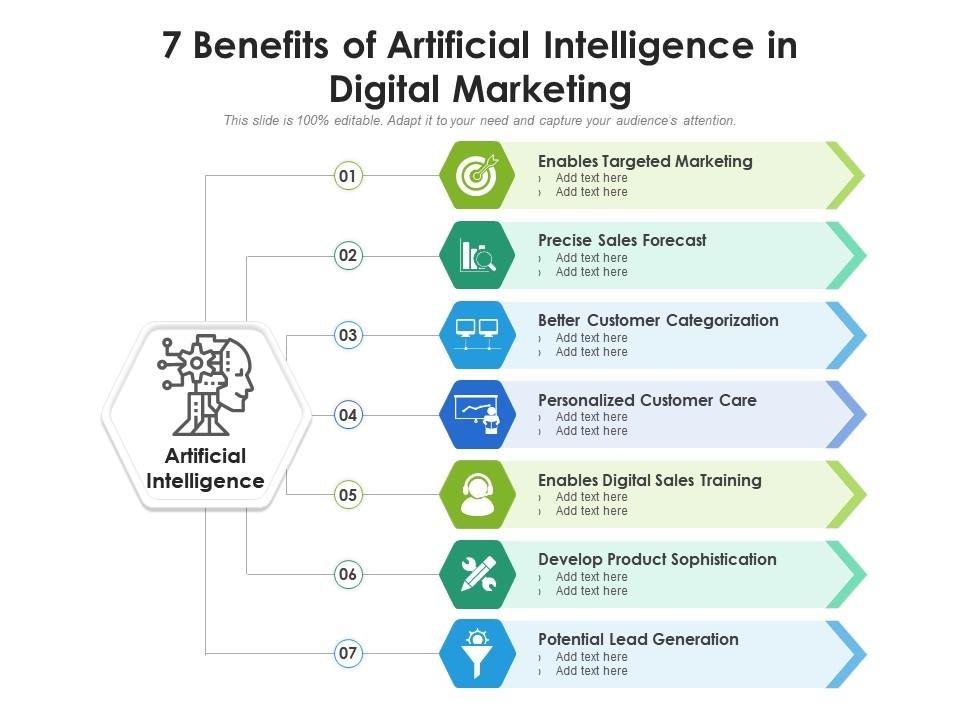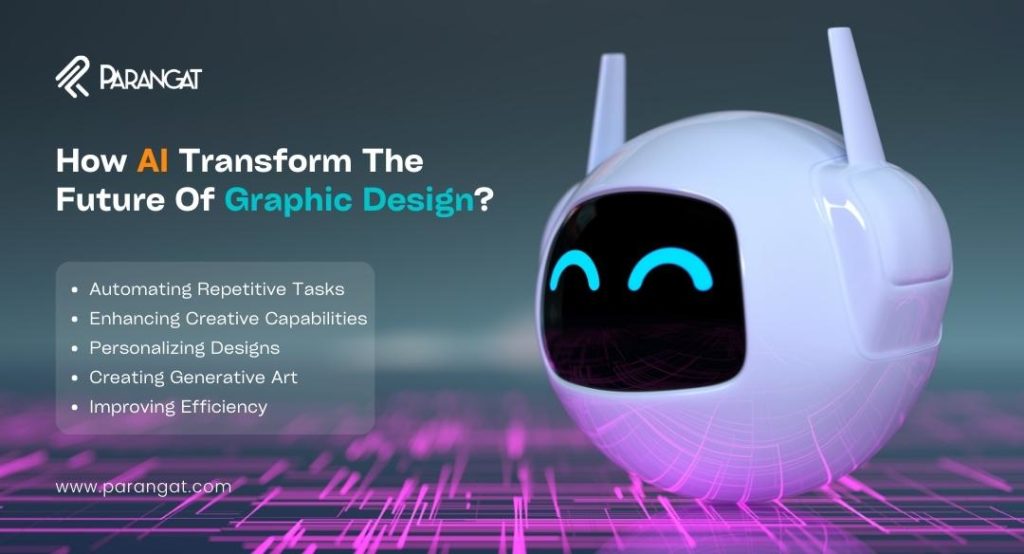The future of graphic design is being transformed by the integration of Artificial Intelligence (AI). With AI-powered tools and algorithms, graphic designers can streamline workflow, enhance creativity, and deliver personalized designs. From automated design generation to predictive analytics and improved efficiency, AI is revolutionizing visual content creation. This article explores AI’s benefits, challenges, and applications in graphic design, showcasing how AI is reshaping the industry and paving the way for a more intelligent and personalized design experience.
What does Artificial Intelligence (AI) mean in Graphic Design?
Artificial Intelligence (AI) in graphic design refers to integrating AI technologies and algorithms into the design process. It involves using intelligent systems that can analyze data, learn patterns, and make decisions to assist designers in creating visual content. AI in graphic design can automate repetitive tasks, generate new design ideas, enhance creativity, and improve the overall efficiency of the design workflow. By harnessing the power of AI, designers can access advanced tools and techniques that help them achieve better results, optimize their designs, and explore new possibilities in visual communication. From automated layout generation to intelligent image editing, AI transforms how designers approach and execute their creative projects.
How Is AI Used In Graphic Design?
AI is used in graphic design across various areas to enhance and streamline the design process. Here are some ways AI is applied in graphic design:
Layout and Composition:
AI algorithms can analyze content and automatically generate layout suggestions based on design principles and user preferences. This assists designers in creating well-balanced and visually appealing compositions.
Color and Typography:
AI can analyze color palettes, recommend harmonious color schemes, and suggest font pairings based on design objectives. This helps designers make informed decisions about color and typography in their designs.
Image Editing:
AI-powered tools can perform advanced image editing tasks such as object removal, background removal, image enhancement, and photo manipulation. These tools utilize machine learning algorithms to process and modify images intelligently.
Design Automation:
AI can automate repetitive design tasks, such as resizing images, creating variations of design elements, or generating templates. This saves time for designers, allowing them to focus on more creative and strategic aspects of their work.
Data Analysis:
AI algorithms can analyze large datasets to extract valuable insights and trends related to user behavior, market preferences, or design performance. This data-driven approach helps designers make data-informed decisions and create designs that resonate with their target audience.
Generative Art:
AI-powered generative models can create unique and original artwork by learning from existing design patterns and generating new variations. This enables designers to explore new creative possibilities and develop fresh design concepts. These AI applications in graphic design help designers streamline their workflow, enhance creativity, and achieve more efficient and effective design outcomes.
Learn: Uses Of Artificial Intelligence For Marketing Analytics
Benefits Of Using AI In Graphic Design
Using AI in graphic design brings several benefits that enhance the design process and outcomes. Here are some critical advantages of utilizing AI in graphic design:

Automating Repetitive Tasks:
AI can automate repetitive and time-consuming tasks such as resizing images, applying filters, or generating design variations. This frees up designers’ time, allowing them to focus on their work’s more strategic and creative aspects.
Enhancing Creative Capabilities:
AI tools and algorithms can assist designers in exploring new design ideas and suggesting layout compositions, color palettes, and font combinations. This expands creative possibilities and encourages designers to think outside the box.
Personalizing Designs:
AI can analyze user data and preferences to create personalized designs tailored to individual users or target audiences. This level of personalization helps businesses connect with their customers on a deeper level and deliver more relevant and engaging designs.
Creating Generative Art:
AI-powered generative models can create unique and original artwork by generating new variations based on existing design patterns. This allows designers to experiment with novel and innovative design concepts.
Improving Efficiency:
AI tools can streamline the design workflow by automating tasks, providing instant feedback, and suggesting design improvements. This improves efficiency and productivity, allowing designers to deliver high-quality designs quickly. Overall, incorporating AI in graphic design empowers designers with advanced tools and capabilities, enabling them to work more efficiently, unleash their creativity, and deliver personalized and impactful designs.
Challenges Of Using AI for Graphic Design
While there are numerous benefits to using AI in graphic design, several challenges also need to be considered. These challenges include:
Lack of Creative Intuition:
AI algorithms lack the human touch and intuition designers possess. They may struggle to fully understand and interpret complex design concepts, resulting in limitations in producing genuinely innovative and artistic designs.
Quality Control and Ethical Concerns:
AI-generated designs may lack the quality and finesse human designers can achieve. Ensuring consistent quality and adhering to ethical standards can be challenging when relying solely on AI systems.
Over Reliance on Templates:
AI tools often rely on existing templates and pre-defined patterns, leading to a lack of originality and uniqueness in designs. Striking a balance between automation and creativity is crucial to avoid creating generic and repetitive designs.
Interpretation of Design Briefs
AI algorithms may struggle to comprehend and interpret complex design briefs or client requirements fully. Understanding the nuances and context of a project may be challenging for AI systems, potentially leading to misinterpretations or design mismatches.
Data Bias and Lack of Diversity
AI algorithms heavily rely on the data they are trained on. If the training data is biased or lacks diversity, it can result in biased design outputs or limited representation of different cultural or aesthetic perspectives.
Skillset Requirements
Adopting AI in graphic design requires designers to acquire new skills and knowledge related to AI technologies. The learning curve and the need for continuous upskilling can challenge some designers. Overcoming these challenges requires a thoughtful and balanced approach, where AI is used to augment human creativity and expertise rather than replace it entirely. Collaboration between AI systems and human designers can lead to more effective and impactful design outcomes.
AI Is Shaping The Future Of Graphic Design
AI-powered graphic design is revolutionizing the industry, offering new possibilities for designers and transforming the way visual content is created. Here’s a closer look at how artificial intelligence is shaping the future of graphic design:

Automated Design:
- AI algorithms can generate designs, layouts, and graphics with minimal human intervention.
- Machine learning algorithms learn from existing designs to develop innovative strategies.
- Automated design saves time and resources, democratizes the design process, and makes it accessible.
Personalization:
- AI enables customization based on user data, creating designs that cater to individual preferences.
- Automated design suggestions consider factors like brand image, target audience, and budget.
- Real-time design adjustments and personalized brand assets provide a customized visual experience.
Improved Efficiency:
- AI automates repetitive tasks like resizing, color correction, and basic layout design.
- AI algorithms analyze images and suggest color schemes based on color theory and branding guidelines.
- Personalized design generation and real-time collaboration streamline workflows and decision-making.
Predictive Analytics:
- Machine learning algorithms predict design trends, consumer preferences, and behavior.
- Designers can quickly test and iterate on designs, identify emerging patterns, and automate tasks.
- AI-powered tools provide insights and recommendations based on consumer data.
Enhanced Accessibility:
- AI assists in font selection, simplifying complex designs, and offering multilingual support.
- Audio descriptions and virtual reality assistance make designs more accessible to diverse audiences.
- AI enhances accessibility by considering factors like legibility, cognitive disabilities, and language translation.
AI is shaping the future of graphic design by automating tasks, enabling personalization, improving efficiency, providing predictive insights, and enhancing accessibility. Embracing AI technologies empowers designers to unlock creativity, efficiency, and innovation, leading to a more dynamic and inclusive approach to visual communication. As AI advances, the possibilities for graphic design are boundless, creating a future where design is both intelligent and tailored to individual needs.
Shaping The Future Of Graphic Design With AI
As Artificial Intelligence continues to evolve and advance, its impact on graphic design becomes increasingly profound. The benefits of AI in graphic design, such as automating repetitive tasks, enhancing creativity, personalizing designs, and improving efficiency, have revolutionized the industry and empowered designers to achieve new levels of innovation. However, challenges, including the lack of creative intuition, quality control concerns, and data bias, must be addressed to harness the full potential of AI in graphic design. By embracing a collaborative approach that combines human creativity and expertise with AI technologies, designers can leverage the capabilities of AI while preserving the unique touch that human designers bring to their craft.
The future of graphic design lies in the synergy between AI and human creativity. As AI continues to shape the industry, designers must adapt and acquire new skills to leverage the power of AI in their work. By embracing AI technologies responsibly and creatively, graphic designers can unlock new possibilities, deliver exceptional designs, and create a more engaging and personalized visual experience for their audience.
With the rapid advancements in AI, the future of graphic design holds immense potential. It will continue to push the boundaries of creativity, efficiency, and accessibility, making design more intelligent, dynamic, and tailored to individual needs. By embracing AI as a tool for innovation, graphic designers can lead the way in shaping the future of visual communication.
To explore the possibilities of AI in graphic design and leverage its benefits for your business, consider partnering with Parangat Technologies. Our AI development services can help you unlock the power of AI to enhance your graphic design capabilities and deliver outstanding results. Contact us today to embark on your journey into the future of graphic design.

With roll up sleeves, dive in and get the job done approach, it was in the year 2010 when Sahil started Parangat Technologies. Emphasizing a healthy work culture and technology-driven company, he has successfully created a workplace where people love to work and live. He is a software engineer and a passionate blockchain enthusiast.


 +44-7511-112566
+44-7511-112566 +353-1-8079571
+353-1-8079571 +1-415-799-9792
+1-415-799-9792

